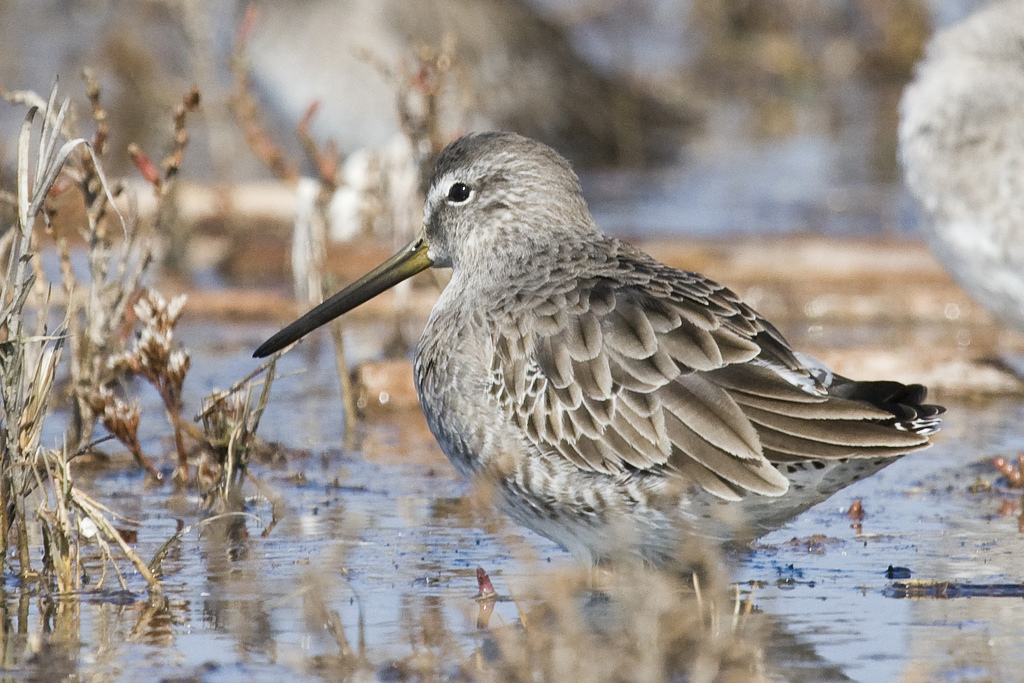- Short-billed Dowitcher
Taxobox
name = Short-billed Dowitcher
status = LC | status_system = IUCN3.1

regnum =Animal ia
phylum = Chordata
classis = Aves
ordo =Charadriiformes
familia =Scolopacidae
genus = "Limnodromus"
species = "L. griseus"
binomial = "Limnodromus griseus"
binomial_authority = (Gmelin, 1789)The Short-billed Dowitcher, "Limnodromus griseus", is a medium-sized
shorebird of the family Scolopacidae. The name of thisbird can be somewhat misleading, as its bill is only short in comparison with theLong-billed Dowitcher . Its long, straight, dark bill is longer than the average shorebird.The body of adults is dark brown on top and reddish underneath. The tail has a black and white barred pattern. The legs are a yellowish color. There are three subspecies with slight variations in appearance:
* "L. g. griseus" has a white belly and barred flanks.
* "L. g. hendersoni" has a reddish belly and spotted flanks.
* "L. g. caurinus" has a white belly with heavily barred flanks and densely spotted breast.None of these combines the reddish belly and barred flanks of the Long-billed Dowitcher. The winter plumage is largely grey.
Their breeding habitat includes bogs, tidal marshes, mudflats or forest clearings south of the tree line in northern
North America . "L. g. griseus" breeds in northernQuebec ; "L. g. hendersoni" breeds in north centralCanada ; "L. g. caurinus" breeds in southernAlaska .These birds nest on the ground, usually near water. Their nests are shallow depressions in clumps of grass or moss, which are lined with fine grasses, twigs and leaves. They lay four, sometimes three, olive-buff to brown eggs. Incubation lasts for 21 days and is done by both sexes.
The downy juvenile birds leave the nest soon after hatching. Parental roles are not well known, but it is believed the female departs and leaves the male to tend the chicks, which find all their own food.
They migrate to the southern
United States and as far south asBrazil . This bird is more likely to be seen near ocean coasts during migration than the Long-billed Dowitcher. This species occurs in westernEurope only as an extremely rare vagrant.These birds forage by probing in shallow water or on wet mud. They mainly eat
insect s,mollusk s,crustacean s and marineworm s, but also eat some plant material.The call of this bird is more mellow than that of the Long-billed Dowitcher, and is useful in identification, particularly of the difficult adult plumages.
References
* Database entry includes justification for why this species is of least concern
* Kaufmann, Ken; "Lives of North American Birds". Houghton Mifflin Books, New York, NY (1996).External links
* [http://www.mbr-pwrc.usgs.gov/id/framlst/i2310id.html Short-billed Dowitcher "Limnodromus griseus"] - USGS Patuxent Bird Identification InfoCenter
* [http://www.birds.cornell.edu/AllAboutBirds/BirdGuide/Short-billed_Dowitcher.html Short-billed Dowitcher Species Account] - Cornell Lab of Ornithology
* [http://www.sdakotabirds.com/species/short_billed_dowitcher_info.htm Short-billed Dowitcher Information] - South Dakota Birds and Birding
* [http://ibc.hbw.com/ibc/phtml/especie.phtml?idEspecie=1508 Short-billed Dowitcher videos] on the Internet Bird Collection
Wikimedia Foundation. 2010.
